|
Grafalgo
Library of useful data structures and algorithms
|
|
Grafalgo
Library of useful data structures and algorithms
|
Data structure for undirected graph. More...
#include <Graph.h>
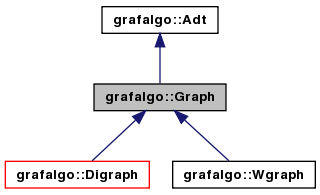
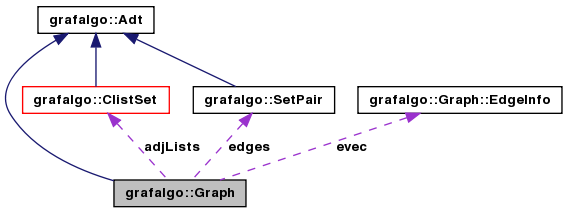
Classes | |
| struct | EdgeInfo |
Public Member Functions | |
| Graph (int=1, int=1) | |
| Construct a Graph with space for a specified number of vertices and edges. | |
| void | clear () |
| Remove all edges from graph. | |
| void | resize (int numv) |
| virtual void | resize (int, int) |
| Resize a Graph object. | |
| void | expand (int numv) |
| virtual void | expand (int, int) |
| Expand the space available for this Graph. | |
| void | copyFrom (const Graph &) |
| Copy into list from source. | |
| int | m () const |
| Get the number of edges. | |
| bool | validVertex (int) const |
| Determine if a vertex number is valid. | |
| bool | validEdge (int) const |
| Determine if an edge number corresponds to a valid edge. | |
| edge | first () const |
| Get the first edge in the overall list of edges. | |
| edge | next (edge) const |
| Get the next edge in the overall list of edges. | |
| virtual edge | firstAt (vertex) const |
| Get the first edge incident to a vertex. | |
| virtual edge | nextAt (vertex, edge) const |
| Get the next edge in the adjacency list for a specific vertex. | |
| vertex | left (edge) const |
| Get the left endpoint of an edge. | |
| vertex | right (edge) const |
| Get the right endpoint of an edge. | |
| vertex | mate (vertex, edge) const |
| Get the other endpoint of an edge. | |
| edge | getEdge (vertex, vertex) const |
| Get an edge joining two vertices. | |
| virtual edge | join (vertex, vertex) |
| Join two vertices with an edge. | |
| bool | remove (edge) |
| Remove an edge from the Graph. | |
| int | getComponents (int *) const |
| Get the components of a graph. | |
| virtual string & | edge2string (edge, string &) const |
| Create a string representation of an edge. | |
| virtual string & | edge2string (edge, vertex, string &) const |
| Create a string representation of an edge. | |
| virtual string & | toString (string &) const |
| Construct a string representation of the Graph object. | |
| virtual string & | toDotString (string &) const |
| Construct a string in dot file format representation of the Graph object. | |
| virtual string & | elist2string (list< int > &, string &) const |
| Create a string representation of an edge list. | |
| void | sortAdjLists () |
| Sort all the adjacency lists. | |
| void | scramble () |
| Scramble the vertices and edges in the graph. | |
| void | rgraph (int, int, int) |
| void | rgraph (int, int) |
| Generate a random graph. | |
| void | addEdges (int) |
| Add random edges to a graph. | |
| void | rbigraph (int, int) |
| Generate a random bipartite graph. | |
| void | rtree (int) |
| Generate a random tree. | |
| void | rcgraph (int, int) |
| Create a random simple, connected graph. | |
Protected Member Functions | |
| void | makeSpace (int, int) |
| Allocate and initialize dynamic storage for Graph. | |
| void | freeSpace () |
| Free space used by graph. | |
| virtual edge | joinWith (vertex, vertex, edge) |
| Join two vertices with a specific edge. | |
| void | shuffle (int *, int *) |
| virtual bool | readAdjList (istream &) |
| Read adjacency list from an input stream, add it to the graph. | |
| virtual string & | adjList2string (vertex, string &) const |
| Create a string representation of an adjacency list. | |
| int | ecmp (edge, edge, vertex) const |
| void | sortAlist (vertex) |
| Sort an adjacency list for a specified vertex using ecmp(). | |
Protected Attributes | |
| int | mm |
| number of edges | |
| int | maxEdge |
| max number of edges | |
| edge * | fe |
| fe[v] is first edge incident to v | |
| EdgeInfo * | evec |
| array of edge structures | |
| SetPair * | edges |
| sets of in-use and free edges | |
| ClistSet * | adjLists |
| set of edge adjacency lists each "edge endpoint" appears on one list; the endpoints for edge e are 2e and 2e+1 | |
Friends | |
| istream & | operator>> (istream &, Graph &) |
| Read one edge from an input stream, add it to the graph. | |
Data structure for undirected graph.
Graph size (number of vertices and max number of edges) must be specified when a Graph object is instantiated. Edges can be added and removed from the graph. Methods are provided to facilitate graph traversal, either by iterating through all edges of the graph or all edges incident to a specific vertex.
| grafalgo::Graph::Graph | ( | int | numv = 1, |
| int | maxe = 1 |
||
| ) |
| void grafalgo::Graph::addEdges | ( | int | nume | ) |
Add random edges to a graph.
| nume | is the target number of edges; if the graph already has some edges, additional edges will be added until the graph has nume edges |
Definition at line 440 of file Graph.cpp.
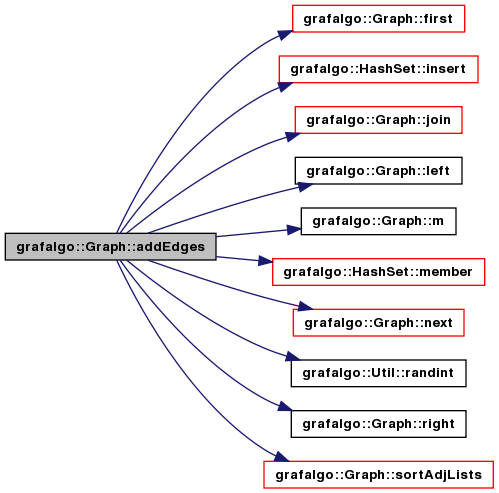

| string & grafalgo::Graph::adjList2string | ( | vertex | u, |
| string & | s | ||
| ) | const [protected, virtual] |
Create a string representation of an adjacency list.
| u | is a vertex number |
| s | is a reference to a string in which the result is returned |
Reimplemented in grafalgo::Digraph, grafalgo::Flograph, grafalgo::Mflograph, grafalgo::Wdigraph, grafalgo::Wflograph, and grafalgo::Wgraph.
Definition at line 276 of file Graph.cpp.


| void grafalgo::Graph::clear | ( | ) | [virtual] |
Remove all edges from graph.
Implements grafalgo::Adt.
Definition at line 75 of file Graph.cpp.

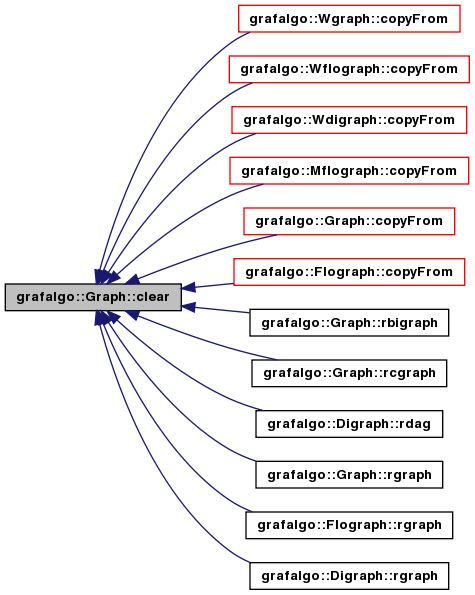
| void grafalgo::Graph::copyFrom | ( | const Graph & | source | ) |
| string & grafalgo::Graph::edge2string | ( | edge | e, |
| string & | s | ||
| ) | const [virtual] |
Create a string representation of an edge.
In the returned string, the "left" endpoint of the edge appears first.
| e | is an edge number |
| s | is a reference to a string in which the result is returned |
Reimplemented in grafalgo::Flograph, grafalgo::Mflograph, grafalgo::Wdigraph, and grafalgo::Wflograph.
Definition at line 237 of file Graph.cpp.


| string & grafalgo::Graph::edge2string | ( | edge | e, |
| vertex | u, | ||
| string & | s | ||
| ) | const [virtual] |
Create a string representation of an edge.
| e | is an edge number |
| u | is one of the endponts of e; it will appear first in the string |
| s | is a reference to a string in which the result is returned |
Reimplemented in grafalgo::Wgraph.
Definition at line 247 of file Graph.cpp.

| string & grafalgo::Graph::elist2string | ( | list< int > & | elist, |
| string & | s | ||
| ) | const [virtual] |
| void grafalgo::Graph::expand | ( | int | numv, |
| int | maxe | ||
| ) | [virtual] |
Expand the space available for this Graph.
Rebuilds old value in new space.
| size | is the size of the resized object. |
Reimplemented in grafalgo::Digraph, grafalgo::Flograph, grafalgo::Mflograph, grafalgo::Wdigraph, grafalgo::Wflograph, and grafalgo::Wgraph.
Definition at line 68 of file Graph.cpp.

| edge grafalgo::Graph::first | ( | ) | const [inline] |
| edge grafalgo::Graph::firstAt | ( | vertex | v | ) | const [inline, virtual] |
Get the first edge incident to a vertex.
| v | is the the vertex of interest |
Reimplemented in grafalgo::Digraph.
Definition at line 159 of file Graph.h.
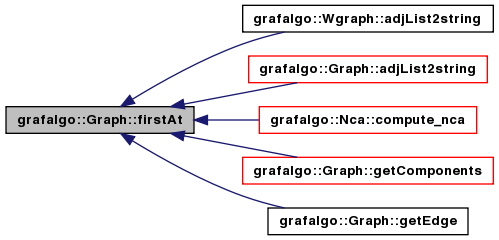
| void grafalgo::Graph::freeSpace | ( | ) | [protected] |
Free space used by graph.
Reimplemented in grafalgo::Digraph, grafalgo::Flograph, grafalgo::Mflograph, grafalgo::Wdigraph, grafalgo::Wflograph, and grafalgo::Wgraph.
Definition at line 47 of file Graph.cpp.

| int grafalgo::Graph::getComponents | ( | int * | component | ) | const |
Get the components of a graph.
| component | is an array that is used to return the result of the computation; if component is not NULL, then it is expected to point to an array with at least n()+1 integers; on return component[u] is an integer "component number"; vertices with the same component number are in the same connected component of the graph; callers interested only in the number of components may use a NULL argument |
Definition at line 611 of file Graph.cpp.
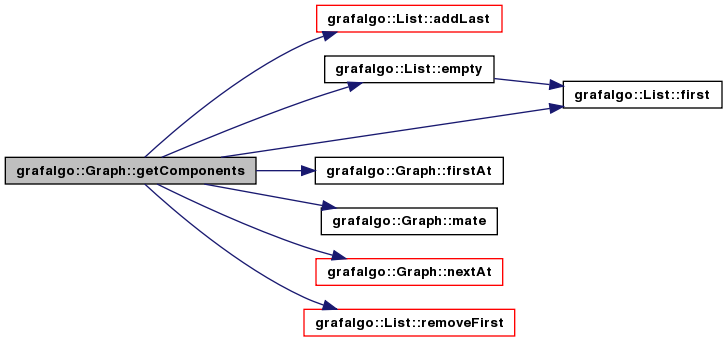

| edge grafalgo::Graph::getEdge | ( | vertex | u, |
| vertex | v | ||
| ) | const |
| edge grafalgo::Graph::join | ( | vertex | u, |
| vertex | v | ||
| ) | [virtual] |
Join two vertices with an edge.
| u | is the left endpoint for the new edge |
| v | is the right endpoint for the new edge |
Reimplemented in grafalgo::Flograph, grafalgo::Mflograph, and grafalgo::Wflograph.
Definition at line 93 of file Graph.cpp.

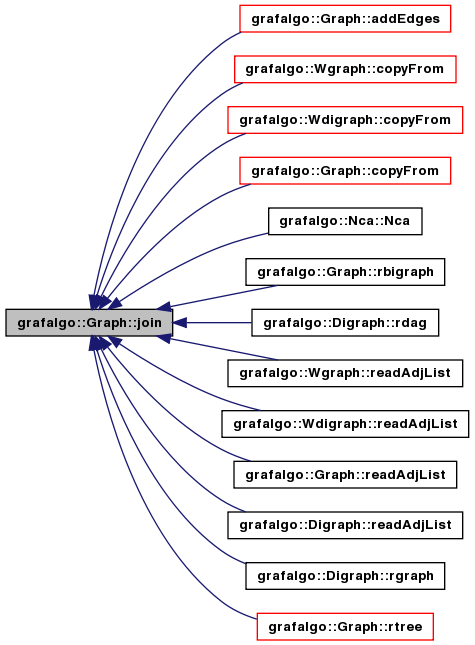
| edge grafalgo::Graph::joinWith | ( | vertex | u, |
| vertex | v, | ||
| edge | e | ||
| ) | [protected, virtual] |
Join two vertices with a specific edge.
| u | is the left endpoint for the new edge |
| v | is the right endpoint for the new edge |
| e | is the number of an idle edge |
Reimplemented in grafalgo::Digraph.
Definition at line 108 of file Graph.cpp.


| vertex grafalgo::Graph::left | ( | edge | e | ) | const [inline] |
| int grafalgo::Graph::m | ( | ) | const [inline] |
| void grafalgo::Graph::makeSpace | ( | int | numv, |
| int | maxe | ||
| ) | [protected] |
Allocate and initialize dynamic storage for Graph.
| numv | is the number of vertices to allocate space for |
| maxe | is the number of edges to allocate space for |
Reimplemented in grafalgo::Digraph, grafalgo::Flograph, grafalgo::Mflograph, grafalgo::Wdigraph, grafalgo::Wflograph, and grafalgo::Wgraph.
Definition at line 28 of file Graph.cpp.

| vertex grafalgo::Graph::mate | ( | vertex | v, |
| edge | e | ||
| ) | const [inline] |
| edge grafalgo::Graph::next | ( | edge | e | ) | const [inline] |
Get the next edge in the overall list of edges.
| e | is the edge whose successor is requested |
Definition at line 153 of file Graph.h.

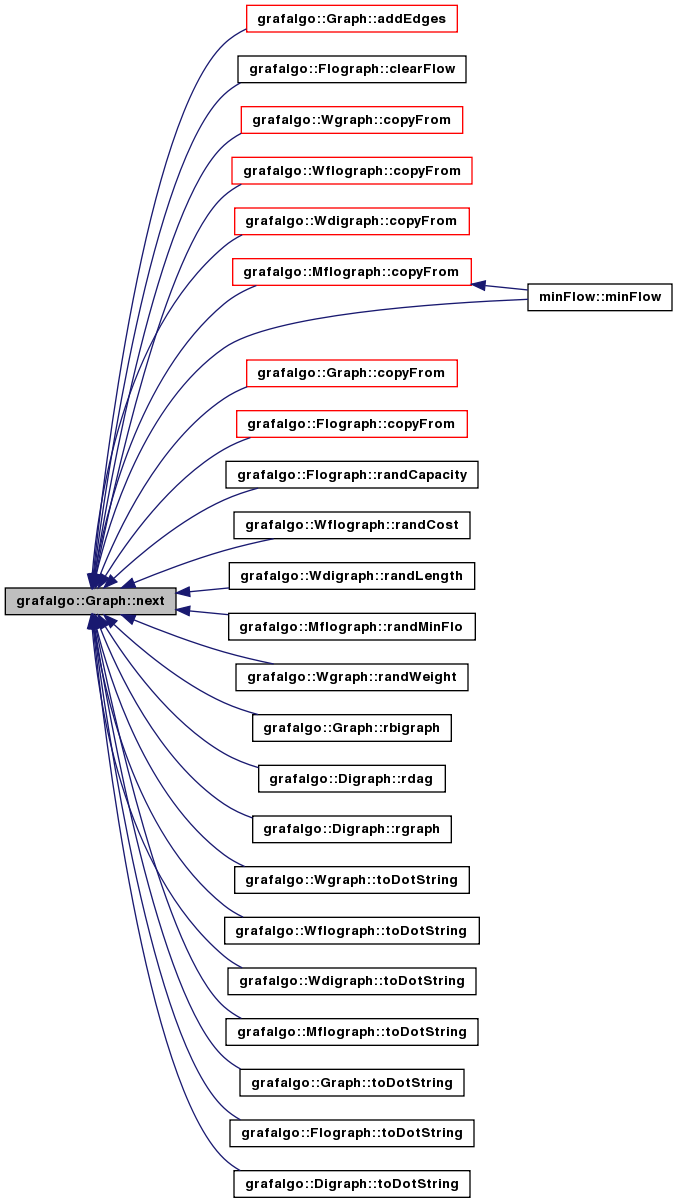
| edge grafalgo::Graph::nextAt | ( | vertex | v, |
| edge | e | ||
| ) | const [inline, virtual] |
Get the next edge in the adjacency list for a specific vertex.
| v | is the edge whose adjacency list we're accessing |
| e | is the edge whose successor is requested |
Reimplemented in grafalgo::Digraph.
Definition at line 170 of file Graph.h.

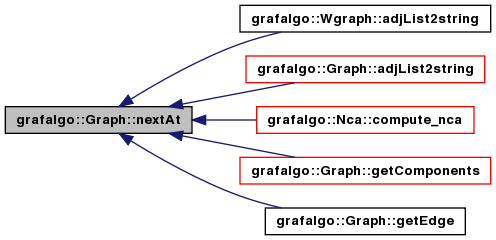
| void grafalgo::Graph::rbigraph | ( | int | numv, |
| int | nume | ||
| ) |
Generate a random bipartite graph.
| numv | specifies the number of vertices per "part"; so the resulting graph will have 2*numv vertices; if this object has n()>2*numv, the random graph is generated over the first 2*numv vertices, leaving the remaining vertices with no edges |
| maxEdge | is the max number of edges in the random graph |
Definition at line 493 of file Graph.cpp.
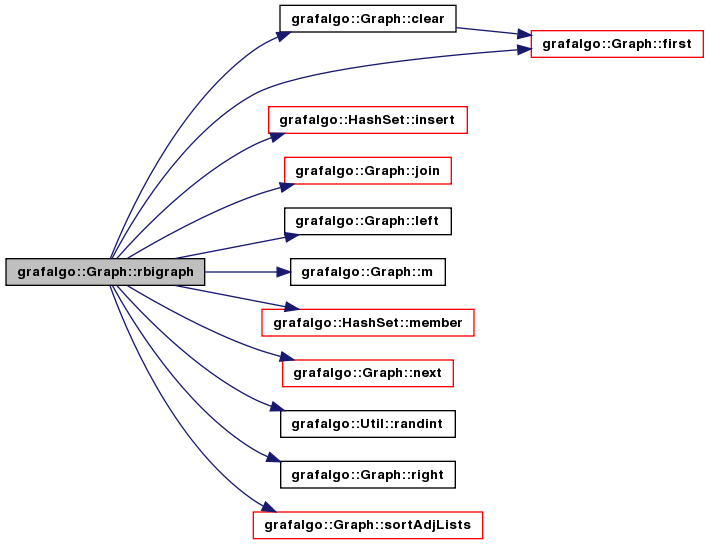
| bool grafalgo::Graph::readAdjList | ( | istream & | in | ) | [protected, virtual] |
Read adjacency list from an input stream, add it to the graph.
| in | is an open input stream |
Reimplemented in grafalgo::Digraph, grafalgo::Flograph, grafalgo::Mflograph, grafalgo::Wdigraph, grafalgo::Wflograph, and grafalgo::Wgraph.
Definition at line 338 of file Graph.cpp.
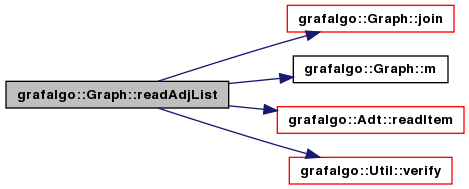
| bool grafalgo::Graph::remove | ( | edge | e | ) |
Remove an edge from the Graph.
| e | is the edge to be removed. |
Reimplemented in grafalgo::Digraph.
Definition at line 132 of file Graph.cpp.
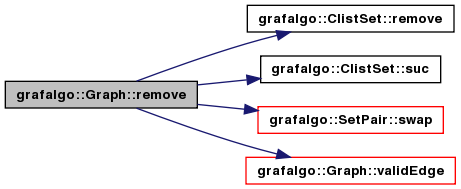
| void grafalgo::Graph::resize | ( | int | numv, |
| int | maxe | ||
| ) | [virtual] |
Resize a Graph object.
The old value is discarded.
| numv | is the number of vertices to allocate space for |
| maxe | is the number of edges to allocate space for |
Reimplemented in grafalgo::Digraph, grafalgo::Flograph, grafalgo::Mflograph, grafalgo::Wdigraph, grafalgo::Wflograph, and grafalgo::Wgraph.
Definition at line 56 of file Graph.cpp.

| void grafalgo::Graph::rgraph | ( | int | numv, |
| int | nume | ||
| ) |
Generate a random graph.
| numv | is the number of vertices in the random graph; if this object has n>numv, the graph is generated over the first numv vertices, leaving the remaining vertices with no edges |
| nume | is the number of edges in the graph |
Reimplemented in grafalgo::Digraph.
Definition at line 428 of file Graph.cpp.

| vertex grafalgo::Graph::right | ( | edge | e | ) | const [inline] |
| void grafalgo::Graph::rtree | ( | int | numv | ) |
Generate a random tree.
Generates random trees with equal probability assigned to each labeled tree; method based on Cayley's theorem
| numv | is the number of vertices in the random tree; if this object has n()>numv, the tree is generated over the first numv vertices, leaving the remaining vertices with no edges |
Definition at line 547 of file Graph.cpp.
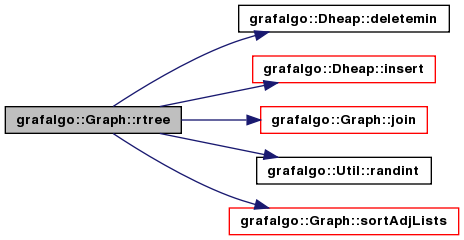

| void grafalgo::Graph::sortAdjLists | ( | ) |
| void grafalgo::Graph::sortAlist | ( | vertex | u | ) | [protected] |
| string & grafalgo::Graph::toDotString | ( | string & | s | ) | const [virtual] |
Construct a string in dot file format representation of the Graph object.
For small graphs (at most 26 vertices), vertices are represented in the string as lower case letters. For larger graphs, vertices are represented by integers.
| s | is a string object provided by the caller which is modified to provide a representation of the Graph. |
Reimplemented in grafalgo::Digraph, grafalgo::Flograph, grafalgo::Mflograph, grafalgo::Wdigraph, grafalgo::Wflograph, and grafalgo::Wgraph.
Definition at line 319 of file Graph.cpp.
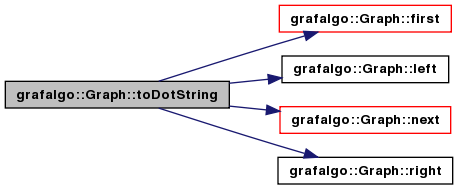
| string & grafalgo::Graph::toString | ( | string & | s | ) | const [virtual] |
Construct a string representation of the Graph object.
For small graphs (at most 26 vertices), vertices are represented in the string as lower case letters. For larger graphs, vertices are represented by integers.
| s | is a string object provided by the caller which is modified to provide a representation of the Graph. |
Implements grafalgo::Adt.
Definition at line 301 of file Graph.cpp.

| bool grafalgo::Graph::validEdge | ( | int | e | ) | const [inline] |
| bool grafalgo::Graph::validVertex | ( | int | u | ) | const [inline] |
| istream& operator>> | ( | istream & | in, |
| Graph & | g | ||
| ) | [friend] |
Read one edge from an input stream, add it to the graph.
Since for undirected graphs, edges appear on both adjacency lists, ignore an edge if its second vertex is larger than the first.
| in | is an open input stream |
| in | is an open input stream |